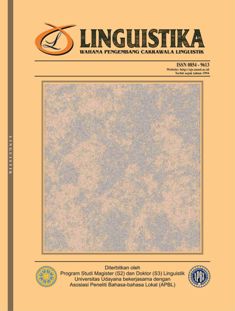STRUKTUR SEMANTIS VERBA ‘NAIK’ DALAM BAHASA JEPANG
Abstract
This article focuses in analyzing the semantic structure of ‘go up’ verb in Japanese language. The data was collected from newspaper article from website asahi.com by observation method and note-taking techniques. The data was analyzed using distribution method. Distribution method was used to analyze semantic structure by using Natural Semantic Metalanguage (NSM) theory developed by Goddard and Wierzbicka (2014). The results shows that ‘go up’ verb in Japanese Language consists of verb noru, noboru, and agaru. Each verb had distinctive features that differentiate one verb to the others.













